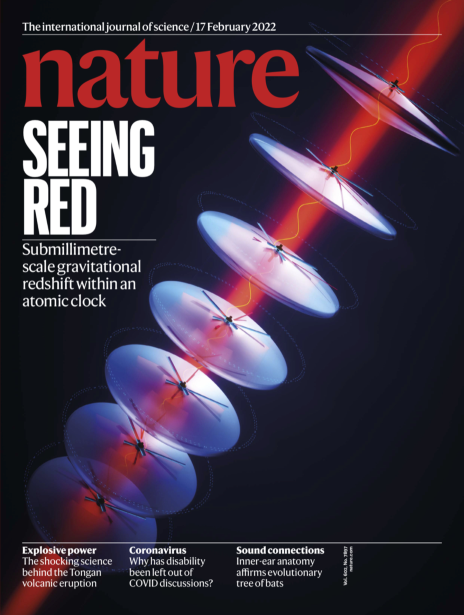Resolving the gravitational redshift across a millimetre-scale atomic sample
| Author | |
|---|---|
| Abstract |
|
| Year of Publication |
2022
|
| Date Published |
2022-01
|
| Journal Title |
Nature
|
| Volume |
602
|
| Issue |
7897
|
| Start Page or Article ID |
420
|
| DOI | |
| URL | |
| Download citation | |
| JILA PI | |
| Publication Highlights |
Cover of Nature Feb. 17 2022 -- SEEING RED
Einstein’s general theory of relativity predicts that Earth’s gravity will sufficiently distort space-time so that clocks at different distances from the planet will tick at different rates — an effect called gravitational redshift. In this week’s issue, Tobias Bothwell, Jun Ye and their colleagues demonstrate this effect at a sub-millimetre scale. The researchers use a cloud of ultracold strontium atoms, effectively creating a series of atomic clocks. As illustrated on the cover, the atoms are trapped in pancake-like optical traps and then interrogated by a laser. The team was able to observe a linear change in frequency — the redshift — from one side of the cloud to the other, showing that each atomic clock was ticking at a slightly different rate. |
| Related Publications | |
| Related JILA Highlights | |
| Associated Institutes | |
Journal Article
|
|
| JILA Topics | |
| Publication Status | |
| Publication Image |

|


 The Physics Frontiers Centers (PFC) program supports university-based centers and institutes where the collective efforts of a larger group of individuals can enable transformational advances in the most promising research areas. The program is designed to foster major breakthroughs at the intellectual frontiers of physics by providing needed resources such as combinations of talents, skills, disciplines, and/or specialized infrastructure, not usually available to individual investigators or small groups, in an environment in which the collective efforts of the larger group can be shown to be seminal to promoting significant progress in the science and the education of students. PFCs also include creative, substantive activities aimed at enhancing education, broadening participation of traditionally underrepresented groups, and outreach to the scientific community and general public.
The Physics Frontiers Centers (PFC) program supports university-based centers and institutes where the collective efforts of a larger group of individuals can enable transformational advances in the most promising research areas. The program is designed to foster major breakthroughs at the intellectual frontiers of physics by providing needed resources such as combinations of talents, skills, disciplines, and/or specialized infrastructure, not usually available to individual investigators or small groups, in an environment in which the collective efforts of the larger group can be shown to be seminal to promoting significant progress in the science and the education of students. PFCs also include creative, substantive activities aimed at enhancing education, broadening participation of traditionally underrepresented groups, and outreach to the scientific community and general public.